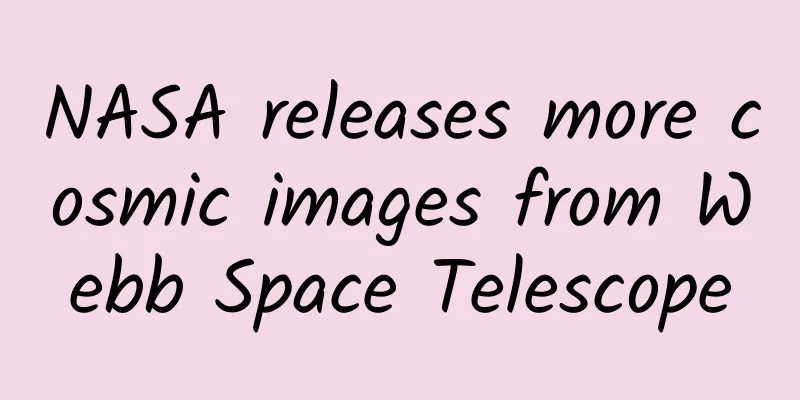NASA releases more cosmic images from Webb Space Telescope

|
After US President Biden released the first full-color image of the deep space taken by the James Webb Space Telescope on the 11th, NASA released more full-color images and spectra of the universe taken by the Webb Space Telescope on the 12th. This is a cosmic image taken by the James Webb Space Telescope and released by NASA on July 12. Xinhua News Agency (Photo provided by NASA) These images include: a spectrum of the exoplanet "WASP-96b" in the Milky Way, which is located in the southern constellation Phoenix about 1,150 light-years from Earth. The spectrum shows for the first time that the planet has features such as water, haze and clouds; the Southern Ring Nebula, which is about 2,000 light-years from Earth, and the image shows the full picture of this planetary nebula; Stephan's Quintet in Pegasus, and the image reveals the speed and composition of the gas near the galaxy's supermassive black hole; the Carina Nebula, and the image shows its earliest, rapid formation stage. The image Biden released on the 11th was taken by the Webb Space Telescope of the "SMACS 0723" galaxy cluster, which contains thousands of galaxies and the faintest celestial body ever observed in infrared light. The size of the starry sky in the vast universe covered by the image is equivalent to a person on the ground looking at a grain of sand after spreading his arms. This is a cosmic image taken by the James Webb Space Telescope and released by NASA on July 12. Xinhua News Agency (Photo provided by NASA) In a press release released on the 12th, NASA said that the first images observed by the Webb Space Telescope tell the story of the unknown universe by showing various stages of cosmic history, including exoplanets and the most distant observable galaxies in the early universe. The communiqué said that the release of the Webb Space Telescope's first images and spectra marked the beginning of its scientific mission. Astronomers around the world will have the opportunity to use the instruments carried by the Webb Space Telescope to observe celestial bodies in the solar system and the early universe. The Webb Space Telescope was jointly developed by NASA, the European Space Agency and the Canadian Space Agency, and is considered the "successor" to the Hubble Space Telescope. The telescope was launched from the Kourou Space Center in French Guiana on December 25, 2021, and successfully entered its orbit around the second Lagrange point of the Sun-Earth system on January 24 this year. This is a cosmic image taken by the James Webb Space Telescope and released by NASA on July 12. Xinhua News Agency (Photo provided by NASA) The Hubble Space Telescope mainly observes in the visible and ultraviolet bands, while the Webb Space Telescope mainly observes in the infrared band. The mission objectives of the Webb Space Telescope include observing how the first galaxies in the universe were born more than 13.5 billion years ago, studying the various stages of galaxy evolution, and observing the formation of stars and planetary systems. This is a cosmic image taken by the James Webb Space Telescope and released by NASA on July 12. Xinhua News Agency (Photo provided by NASA) This is a cosmic image taken by the James Webb Space Telescope and released by NASA on July 12. Xinhua News Agency (Photo provided by NASA) |
<<: It's here again! Why are there so many supermoons? What are the highlights?
Recommend
From paper airplanes to hypersonic speeds, how do aircraft wings evolve?
Produced by: Science Popularization China Author:...
How much does it cost to make a shoe and boots mini program in Yueyang?
How much is the quotation for shoe and boot manuf...
A must-read for H5 game channel operations: current situation, difficulties and future
It has been almost a year since I left a big web ...
China's auto market: Tesla's sales in January 2025 fell 11.5% year-on-year, while BYD's sales increased 47%
Affected by increasingly fierce market competitio...
Aging doesn’t just show up on your face! If you have these 10 signs, you’re getting older…
This article was reviewed by Zhu Hongjian, Chief ...
Winter Solstice "Nine Days"|When you count to ninety-nine days, will spring come?
The winter solstice has arrived, which means we h...
First experience of watching TV series while charging
With the popularity of mobile phones, mobile powe...
Can jokes cure dry eyes? This is no joke!
There are some lines in the classic crosstalk &qu...
The Winter Olympics is coming, but you still don’t know the difference between short track speed skating and speed skating?
The opening of the Beijing Winter Olympics is get...
Three key cores of new media marketing promotion plan!
All things are difficult at the beginning. What i...
People's Daily: Although some people are trying to contain China, China must not close its doors to innovation
On May 28 this year, Comrade Xi Jinping emphasize...
When her son ate his classmate’s birthday cake, his mother angrily claimed in the WeChat group that he was “poisoned”. Is it really true that you can’t eat a single bite of vegetable cream?
A piece of social news has sparked heated discuss...
Zheng Xiangzhou-New Business Model Complete Works Value 12980
Zheng Xiangzhou-New Business Model Complete Works...
Sharing the application skills of six carriers of private domain traffic!
When we talk about private domain traffic , we ge...









